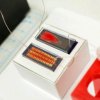The 2010 Nobel Prize for Physics went to two scientists who found a simple way to isolate a single layer of graphite, called graphene. It is a 2D sheet of carbon atoms arranged in a hexagonal lattice, that makes for the thinnest, most electrically and thermally conductive material in the world, while also being flexible, transparent and incredibly strong. Graphene’s myriad of outstanding properties earned it the name “wonder material”, and many believe that the 21st century will become the ‘Graphene Age’.
grapheneGraphene is indeed a much-researched, heavily-hyped material, with the potential to revolutionize every aspect of our lives: from selective membranes that may solve the world’s water shortage, through replacing silicon in electronics to achieve amazing performance in miniature sizes, to enabling a multitude of next-gen energy solutions. Graphene’s prospects of spearheading innovations, however, do not stop at ‘green power’ solar cells or cell phone batteries that recharge within minutes; Graphene’s compatibility with various biomedical applications, like drug delivery, cancer therapies and biosensing, is extensively and vigorously researched. The material’s unique properties, like a large surface area, good biocompatibility and chemical stability, deem it worthy of intensive examination and high hopes.
Artificial implants are a medical staple, and graphene could play a crucial role in the future of these devices. Graphene’s biocompatibility, coupled with its mechanical strength, is beneficial for various composite bio-materials and its electrical conductivity can be used for organs that require such attributes, like nerve tissues and spinal elements. In fact, researchers at the Michigan Technological University are gaining progress in their work to 3D print replacement nerves using 3D bioprinting techniques. The team has developed polymer materials that can act as a scaffold for growing tissues and is working on integrating graphene as the electrical conductor.
Bio-sensing is a growing field, with many medical applications that come to mind. Many avenues are explored along these lines, with graphene showing exceptional performance in detecting food toxins, environmental pollution, specific germs and bacteria and more. Graphene-oxide, an oxygenated form of graphene, binds to the protein-like structure of specific toxins to produce an enhanced signal that enables hyper-sensitive sensors that detect toxins at level of about 10 times lower than conventional sensors. Another example is a sensor that predicts heart attacks, using graphene-oxide’s ability to detect specific microparticles in the blood that are released prior to heart attacks. Various similar sensors are currently under research and development for the detection of a multitude of diseases, toxins and biomarkers.
Graphene has great potential for the detection and treatment of cancer. As far as sensitive detection goes, Chinese scientists developed a single-cell sensor based on graphene field-effect transistors, able to detect even a single cancer cell! But perhaps more interesting is graphene’s potential in cancer treatment; University of Manchester scientists found that graphene oxide may act as an anti-cancer agent that selectively targets cancer stem cells. Combined with existing treatments, this could lead to tumor shrinkage as well as preventing the spread of cancer and its recurrence after treatment. Graphene is also vastly studied for applications in cancer drug delivery, mostly due to its large surface area that allows it to transport massive amounts of drugs to specific sites in the body. In addition to cancer detection and drug delivery, graphene itself is studied as an anti-cancer agent – focusing, for instance, on its thermal conductivity and ability to convert non-ionizing radio waves into heat energy at microscopic levels and create enough heat to eliminate proteins and DNA inside cancer cells.
DNA sequencing, or determining the sequence of bases in DNA that make up the genome, is of great importance for not only gaining a better understanding of the human make-up, but also for comprehending any number of genetic diseases, cancer types and the human immune systems. Graphene-enabled DNA sequencing is usually based on creating a graphene membrane, immersing it in conductive fluid and applying a voltage to one end so DNA can be drawn through the graphene’s miniscule pores. This method is called nanopore sequencing and it would allow DNA to be analyzed one nucleotide at a time (each nucleotide affecting the membrane differently due to its unique dimensions and electrical properties). Additional concepts involve graphene-based DNA sensors, and other alternative ways of making DNA sequencing faster and more efficient.
Nanomedicine is currently still in its infancy, and so is the use of graphene for medical applications. Its great promise to enter and revolutionize many medical fields, however, encourages much research and development efforts, and the future will hopefully see more effective, longer lasting preventative and treatment methods with enabled by graphene.
source:Graphene
Graphene: The Next Medical Revolution

